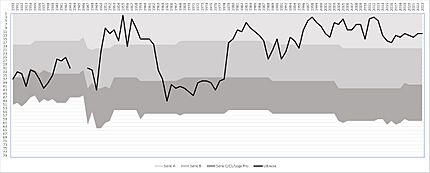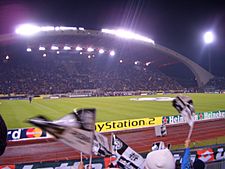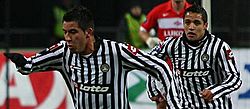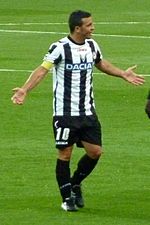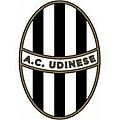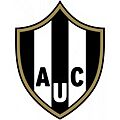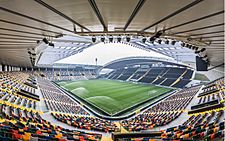Udinese Calcio facts for kids
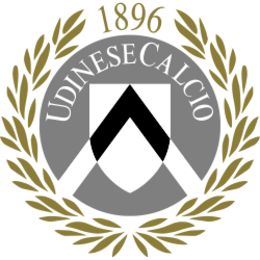 |
||||
| Full name | Udinese Calcio S.p.A. | |||
|---|---|---|---|---|
| Nickname(s) | I Bianconeri (The White and Blacks) I Friulani (The Friulians) Le Zebrette (The Little Zebras) |
|||
| Founded |
|
|||
| Ground | Bluenergy Stadium | |||
| Capacity | 25,132 | |||
| Owner | Giampaolo Pozzo | |||
| President | Franco Soldati | |||
| Head coach | Kosta Runjaić | |||
| League | Serie A | |||
| 2018–19 | Serie A, 12th of 20 | |||
|
||||
Udinese Calcio is a professional football club. It is based in Udine, a city in Friuli-Venezia Giulia, Italy. The team plays in Serie A, which is the top football league in Italy.
The club was started on November 30, 1896, as a general sports club. It became a football club on July 5, 1911. Udinese's home uniform is a black and white striped shirt, black shorts, and white socks. The club has its own TV channel, Udinese Channel, for fans in northeastern Italy. Many people in the Friuli area support the team.
Contents
Club History: A Journey Through Italian Football
How Udinese Started and Its First Games
Udinese Calcio began in 1896. It was part of a bigger sports group called Società Udinese di Ginnastica e Scherma. This means "Udinese Society of Gymnastics and Fencing." In its first year, the club won a local tournament in Treviso. They beat Ferrara 2–0. However, this win is not officially recognized.
On July 5, 1911, some gymnasts from Udinese formed the A.C. Udinese football club. Luigi Dal Dan led this group. The new team played its first friendly match against Juventus and won 6–0.
Udinese first played in an official league in the 1912–13 season. They joined the Campionato Veneto di Promozione. This league had only three teams. Udinese won two games against Padova. They finished second, which helped them move up to the top league, Prima Categoria. In this league, Udinese could not reach the national finals. They were always stopped in the regional rounds.
1920s: Reaching a Cup Final
The 1920–21 season was special. It was when Gino Bellotto first played for Udinese. He played for the club for 17 seasons, more than any other player.
In 1922, Udinese made it to the Coppa Italia final. They lost 1–0 to Vado after extra time. This was a big achievement for the club. In the league, Udinese finished second in their group. This allowed them to stay in the top division.
The 1922–23 season was tough. Udinese finished last and was moved down to the second division. The team also faced money problems in 1923. The club's president, Alessandro Del Torso, sold some of his paintings to pay off the debts. This saved the club. Udinese then joined the Second Division and finished fourth.
The 1924–25 season was exciting. Udinese was in a close race for promotion. They had to play extra games to decide the winner. Udinese won a playoff against Olympia. They also played against Vicenza. Udinese eventually won the playoff after Vicenza used a player who was not allowed to play. This helped Udinese move up to the First Division.
In the next season, Udinese finished 10th and was moved down again. However, the league rules changed. Udinese got another chance to stay in the top league. They played in special playoffs but lost. So, they lost their spot in the top league.
Udinese stayed in the Second Division until the 1928–29 season. That year, Serie A and Serie B were created. Udinese ended up in the third tier, called Terza Serie. Their first season in Terza Serie was a big success. Udinese won promotion back to Serie B.
1930s and 1940s: Moving Up and Down
Udinese stayed in Serie B for only two years. After the 1931–32 season, the team went back to the third division. They remained in the third tier, later called Serie C, until the 1938–39 season. That year, they finished second in their group and were promoted to Serie B.
The team stayed in Serie B for about twelve years. Their performance was usually average. They were moved down to Serie C again at the end of the 1947–48 season. This happened because of new league rules. But after this, Udinese quickly earned two promotions in a row. They finished second in Serie B 1949-50, which was a historic promotion to Serie A.
1950s: Almost Winning the Top League
Udinese played in Serie A for five seasons. In the 1954–55 season, they almost won the league title, known as the Scudetto. They finished second, right behind Milan. However, after that season, Udinese was moved down. This was because of a rule violation that happened two years earlier.
The team returned to Serie A after just one season in Serie B. In the following season, they showed they were one of Italy's best teams. They finished in an excellent fourth place.
1960s and 1970s: A Period of Decline and Comeback
After their good seasons, Udinese's performance dropped. They were moved down to Serie B in 1961–62. Then, they went down to Serie C in 1963–64. Udinese stayed in Serie C for about fifteen years. They tried many times to get back to Serie B but did not succeed.
Finally, after the 1977–78 season, the team made a comeback. Led by manager Massimo Giacomini, they returned to Serie B. In the same season, they won the Coppa Italia Semiprofessionisti (a cup for semi-professional teams). They also won the Anglo-Italian Cup.
1980s: European Success and a Scandal
In the next season, Udinese, still with Massimo Giacomini as manager, won Serie B. They returned to Serie A after more than twenty years. In their first year back, the team managed to avoid being moved down. In Europe, they did much better. They won the Mitropa Cup. This was a European cup for teams that had won their second-tier league the previous season.
In the following seasons, the team stayed in Serie A without much trouble. They even finished in an impressive sixth place in 1982–83. At that time, Udinese had one of its greatest players ever, the Brazilian midfielder Zico.
At the end of the 1985–86 season, the team was involved in a betting scandal. They were penalized nine points for the 1986–87 season. Despite a strong effort to catch up, Udinese was moved down to Serie B. If they had not lost those points, Udinese would have stayed in Serie A.
1990s and Early 2000s: Playing in Europe
In the years that followed, Udinese was promoted to Serie A and then moved back to Serie B several times. This continued until the 1995–96 season. From that point on, they became a regular team in Serie A.
The 1996–97 season saw Udinese qualify for the UEFA Cup. This was under manager Alberto Zaccheroni. The next season, they finished third in Serie A. This was largely thanks to Oliver Bierhoff's 27 goals.
In March 2001, Luciano Spalletti became manager. He helped the team avoid being moved down. After short periods with other managers, Spalletti returned to Udinese at the start of the 2002–03 season. The club was well-organized and ambitious. They reached the UEFA Cup again, playing exciting football.
In the 2004–05 season, Udinese finished in a surprising fourth place. This earned them their first qualification for the UEFA Champions League in club history. After that season, Spalletti decided to leave Udinese.
The next season, Udinese played in the Champions League qualifying round. They beat Sporting CP 4–2. Udinese was placed in a tough group with Panathinaikos, Werder Bremen, and Barcelona.
They won their first match 3–0 against Panathinaikos. Vincenzo Iaquinta scored three goals in that game. However, the team did not make it to the knockout rounds. They finished third in their group.
Recent History: Ups and Downs
After a year in the Champions League, Udinese finished tenth. They returned to being a mid-table team. Things changed in the summer of 2007. The club hired Sicilian manager Pasquale Marino. They also bought good players like Fabio Quagliarella and Gökhan Inler.
The 2007–08 season started well with a draw against champions Internazionale. But a 5–0 loss to Napoli quickly ended the excitement. After that, Udinese's luck changed. They won against Juventus with a late goal from Antonio Di Natale. Udinese was in the race for a Champions League spot until the end of the season. They finished seventh, qualifying for the UEFA Cup.
At the start of the 2008–09 season, Udinese launched its own Web TV channel. It was called Udinese Channel. This was new for Italian football clubs.
In the 2008–09 season, Udinese had mixed results in Serie A. They won against Roma and Juventus. But 10 losses hurt their chances for Champions League. In the UEFA Cup, Udinese was in a tough group. They easily moved through it with a 2–0 win against Tottenham. They beat Lech Poznań and then Zenit Saint Petersburg. In the quarter-final against Werder Bremen, they lost 6–4. Fabio Quagliarella scored eight goals in that competition. They finished seventh in the league, missing out on European football for the next year.
The 2009–10 season was very disappointing. Even though Antonio Di Natale scored 29 goals and was the top scorer, the team fought against being moved down. They finished 15th, safe from relegation. The only good part was reaching the semi-final of the Coppa Italia. They lost to Roma.
In the summer of 2010, Udinese sold some key players. But they also brought in new players like Mehdi Benatia and Pablo Armero. These players were important for their success in the 2010–11 Serie A. After a bad start, Udinese had their highest points total ever. They finished fourth, earning a spot in the Champions League qualifying round. Di Natale scored 28 goals. He was the first player to be top scorer two years in a row since Lazio's Giuseppe Signori. A 0–0 draw with Milan on the last day secured their Champions League spot. Coach Francesco Guidolin even danced to celebrate. In the Coppa Italia, Udinese lost to Sampdoria.
The 2011–12 season continued well. Udinese lost three key players to bigger clubs. These included Alexis Sánchez to Barcelona. In the Champions League qualifying round, Udinese played against Arsenal. They lost 3–1 on total score. Antonio Di Natale missed a penalty that could have helped Udinese win. They then entered the Europa League group stage. In Italy, Udinese started strong. They had the best defense after 15 games. For the second year in a row, Udinese qualified for the Champions League. They finished third on the last day of the season. In the summer, Kwadwo Asamoah and Mauricio Isla were sold to Juventus. The club did not reach the Champions League group stage that year. They lost to SC Braga from Portugal in a penalty shootout. Antonio Di Natale scored 23 goals. This was his third straight season with 20+ goals in Serie A.
Udinese started the 2012–13 Serie A season with mixed results. They had many draws and losses in their first games. But starting in December, the team began to win more often. Di Natale also started scoring regularly. The team then had an amazing eight-game winning streak to end the season. Luis Muriel became a very important player. Di Natale again scored 23 goals. He was the first player since Gabriel Batistuta to score 20 or more goals in four or more seasons in a row.
In the years after, Udinese usually finished in the middle or lower part of the Serie A table. In the 2017–18 season, manager Massimo Oddo was fired after the club lost 11 games in a row. Igor Tudor took over and helped the club stay safe from being moved down.
Team Colors and Symbols
Team Colors
Udinese's official colors are white and black. These are the same colors as the city's coat of arms. The team has used these colors on their uniforms since the beginning.
In the late 1800s, the club wore a completely black shirt. It had a white five-pointed star on the chest. In the 1910s, the shirt was split vertically into black and white. Later, white became the main color, with black used for details. Since the 1930s, the typical black and white striped shirt has been used almost all the time. It is often worn with black shorts and socks, or white shorts and black socks.
Some changes happened in the 1980s. The team's uniforms became more creative. For example, they used white shirts with a black stripe in the middle. Then, they had black shirts with a large white stripe. From the 1990s, they slowly went back to simpler designs.
Away uniforms do not have a fixed pattern. The club changes colors every year. They have used blue, yellow, orange, sky blue, pink, and even black and white for their away kits.
Official Symbols
Crest
Udinese has used many different crests throughout its history. These crests always use the colors and symbols of the city of Udine. An old photo from around 1896 shows the city's coat of arms on a black shirt. But it is not clear if this was an official or continuous symbol. Later photos from the early 1900s do not show any emblem on the shirts.
The first official emblems appeared in the 1950s, 60s, and 70s. These emblems showed a shield with black and white vertical stripes. They first had "AC Udinese" written on them, then "ACU" (Associazione Calcistica Udinese). The first emblem seen on a shirt was in 1979. It showed a zebra inside a green circle.
A second symbol was introduced in the early 1980s. It was a white shield with a black chevron. This is the same design that represents the city of Udine. Below it was the "Z" logo of Zanussi, the company that owned the club. Even though this was the official emblem, for the 1981-1982 season, the shirts only showed a large "Z" on the chest.
The third emblem was a change of the second one. After Zanussi left, the "Z" was removed. Only the shield with the city's emblem remained. Then, between 1992 and 1995, the club used a round emblem for the first time. It had the city's coat of arms in the middle, surrounded by a gray circle.
Finally, in the 1995-1996 season, the current emblem was first used. It is a shield surrounded by a circle. This circle was first gray, then black, and from the 2010-2011 season, it became gray again. Two laurel branches are wrapped around it.
Fans have often asked for the Friulian eagle to be added to the shirts. But the club has not agreed, partly because of rules. In 2008, the club decided to put the emblem of Friuli-Venezia Giulia on the shirts. Fans strongly disagreed. They felt it represented rival Trieste more than Friuli.
Anthem
The club's official song is "Vinci per noi" (Win for Us). It is sung by Connie Del Colle. This song is played before every home game at the Stadio Friuli.
Before this, the anthem was "Alè Udin," sung by Dario Zampa. Its chorus became a popular chant for the Udinese fans.
Club Achievements: Trophies and Honors
National Titles
League Wins
Cup Wins
- Coppa Italia Serie C
- Winners (1): 1977–78
International Titles
- UEFA Intertoto Cup
- Winners (1): 2000
Other Important Titles
- Anglo-Italian Cup
- Winners (1): 1978
- Mitropa Cup
- Winners (1): 1979–80
Where Udinese Has Played: Stadiums
- Stadio Moretti (1924–1976)
- Stadio Friuli (1976–Present)
Players: Current Squad and Notable Stars
Current Squad
|
|
Players on Loan
|
|
Other Players Under Contract
|
|
Famous Players Who Played for Udinese
Many talented players have represented Udinese. Here is a list of some notable players who played for their national teams while at Udinese, grouped by their home country:
 Abel Balbo
Abel Balbo Roberto Pereyra
Roberto Pereyra Daniel Bertoni
Daniel Bertoni Nahuel Molina
Nahuel Molina Rodrigo De Paul
Rodrigo De Paul Juan Musso
Juan Musso Mauricio Pineda
Mauricio Pineda Néstor Sensini
Néstor Sensini Roberto Sosa
Roberto Sosa Régis Genaux
Régis Genaux Johan Walem
Johan Walem Edinho
Edinho Felipe
Felipe Márcio Amoroso
Márcio Amoroso Zico
Zico Mauricio Isla
Mauricio Isla David Pizarro
David Pizarro Alexis Sánchez
Alexis Sánchez Juan Cuadrado
Juan Cuadrado Cristián Zapata
Cristián Zapata Antonín Barák
Antonín Barák Jakub Jankto
Jakub Jankto Marek Jankulovski
Marek Jankulovski Thomas Helveg
Thomas Helveg Martin Jørgensen
Martin Jørgensen Per Krøldrup
Per Krøldrup Jens Stryger Larsen
Jens Stryger Larsen Morten Bisgaard
Morten Bisgaard Hazem Emam
Hazem Emam Oliver Bierhoff
Oliver Bierhoff Carsten Jancker
Carsten Jancker Stephen Appiah
Stephen Appiah Kwadwo Asamoah
Kwadwo Asamoah Asamoah Gyan
Asamoah Gyan Sulley Muntari
Sulley Muntari Emmanuel Badu
Emmanuel Badu Orestis Karnezis
Orestis Karnezis Ali Adnan
Ali Adnan Valerio Bertotto
Valerio Bertotto Alessandro Calori
Alessandro Calori Franco Causio
Franco Causio Morgan De Sanctis
Morgan De Sanctis Antonio Di Natale
Antonio Di Natale Stefano Fiore
Stefano Fiore Giuliano Giannichedda
Giuliano Giannichedda Vincenzo Iaquinta
Vincenzo Iaquinta Simone Pepe
Simone Pepe Paolo Poggi
Paolo Poggi Paolo Pulici
Paolo Pulici Fabio Quagliarella
Fabio Quagliarella Dino Zoff
Dino Zoff Seko Fofana
Seko Fofana Mehdi Benatia
Mehdi Benatia Marek Koźmiński
Marek Koźmiński Odion Ighalo
Odion Ighalo Bruno Fernandes
Bruno Fernandes Igor Shalimov
Igor Shalimov Dušan Basta
Dušan Basta Željko Brkić
Željko Brkić Aleksandar Luković
Aleksandar Luković Samir Handanović
Samir Handanović Ricardo Gallego
Ricardo Gallego Arne Selmosson
Arne Selmosson Valon Behrami
Valon Behrami Gökhan Inler
Gökhan Inler Silvan Widmer
Silvan Widmer Festy Ebosele
Festy Ebosele James Abankwah
James Abankwah Ivica Šurjak
Ivica Šurjak
Coaching Staff: Who Leads the Team
| Position | Staff |
|---|---|
| Head coach | |
| Assistant head coach | |
| Technical assistant | |
| Head goalkeeping coach | |
| Goalkeeping coach | |
| Match analyst | |
| Match analyst collaborator | |
| Head of athletic coach | |
| Athletic coach | |
| Athletic coach and data analyst | |
| Head of medical | |
| First team doctor | |
| Head physiotherapist | |
| Rehabilitation and gym trainer | |
| Head nutritionist | |
| Nutritionist | |
| Podiatrist | |
| Physiotherapist coordinator | |
| Physiotherapist | |
| Kit manager | |
| Chief executive officer | |
| Technical director | |
| Team manager | |
| Press office | |
| Director of professional football and scout | |
| Chief scout | |
| Youth scout |
Managerial History: The Coaches of Udinese
Here is a list of the managers who have led Udinese throughout its history.
|
|
|
|
See also
 In Spanish: Udinese Calcio para niños
In Spanish: Udinese Calcio para niños


